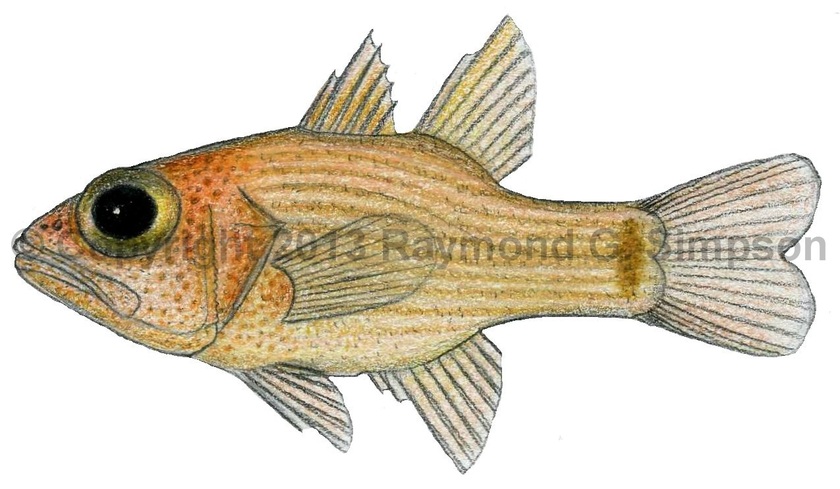
Common Name
Dwarf Cardinalfish
Year Described
Dale, 1977
Identification
Dorsal Fin: VI, I-9
Anal Fin: II, 8
Pelvic Fin: I, 5
Pectoral Fin: 12
Gill Rakers: 14-16 on lower
Vertebrae: 10 precaudal, 14 caudal
A small fish with a fairly robust, stout, and moderately compressed body. Eye is large and the snout short. Interorbital wider (8.2-10.4% SL). Mouth is fairly large and oblique, with the lower jaw slightly protruding. Both jaws, palatine, and vomer with narrow bands of villiform teeth (no canines). Preopercular edge with a finely serrate margin. Preopercular flap does not extend past the preopercular rear margin. There are two dorsal fins. The caudal fin is bluntly emarginate. Body scales ctenoid.
Color
Body pale orange, salmon, or light brown with several very faint pale brown stripes on the body from the gill edge to the caudal peduncle. Orange and brown melanophores on head. An oval to rectangular diffuse blotch on the caudal peduncle often reaches the dorsal and ventral midline. The fins are translucent to pale yellow.
Size
Maximum size to 34mm TL.
Habitat
Coral reefs and adjacent area from 12-40m. Found in association with anemones, seagrass beds, and rubble zones.
Range
Scattered records from the Bahamas, Belize, Haiti, and Jamaica.
References
Baldwin, C. C., Brito, B. J., Smith, D. G., Weigt, L. A. and Escobar-Briones, E. 2011. Identification of early life-history stages of Caribbean Apogon (Perciformes: Apogonidae) through DNA Barcoding. Zootaxa, 3133: 1-36.
Gon, O. 2002. Apogonidae (pp 1386-1391). In: Carpenter. 2002. The living marine resources of the Western Central Atlantic. Vol. 3: Bony fishes part 2 (Opistognathidae to Molidae), sea turtles and sea mammals. FAO Species Identification Guides for Fisheries Purposes. American Society of Ichthyologists and Herpetologists Special Publication No. 5.
Other Notes
Closely related to Apogon robbyi and A. quadrisquamatus. Distinguished from the former by color pattern and interorbital width and the latter by color pattern and gill raker counts.